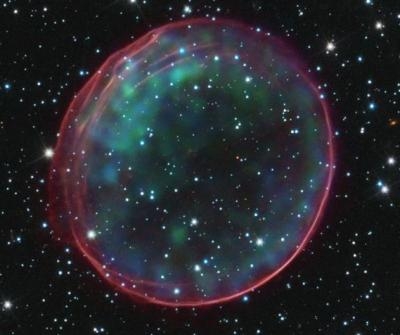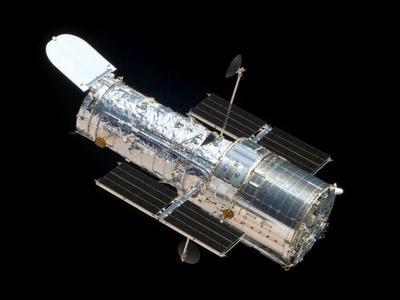Several Different Scenarios Could Have Led To The Event
Using NASA's Hubble Space Telescope, astronomers have solved a
longstanding mystery on the type of star, or so-called progenitor,
which caused a supernova seen in a nearby galaxy. The finding
yields new observational data for pinpointing one of several
scenarios that trigger such outbursts. Based on previous
observations from ground-based telescopes, astronomers knew the
supernova class, called a Type Ia, created a remnant named SNR
0509-67.5, which lies 170,000 light-years away in the Large
Magellanic Cloud galaxy.
Supernova As Seen By Hubble

Theoretically, this kind of supernova explosion is caused by a
star spilling material onto a white dwarf companion, the compact
remnant of a normal star, until it sets off one of the most
powerful explosions in the universe. Astronomers failed to find any
remnant of the companion star, however, and concluded that the
common scenario did not apply in this case, although it is still a
viable theory for other Type Ia supernovae. "We know Hubble has the
sensitivity necessary to detect the faintest white dwarf remnants
that could have caused such explosions," said lead investigator
Bradley Schaefer of Louisiana State University (LSU) in Baton
Rouge. "The logic here is the same as the famous quote from
Sherlock Holmes: 'when you have eliminated the impossible, whatever
remains, however improbable, must be the truth.'"
The cause of SNR 0509-67.5 can be explained best by two tightly
orbiting white dwarf stars spiraling closer and closer until they
collided and exploded.
For four decades, the search for Type Ia supernovae progenitors
has been a key question in astrophysics. The problem has taken on
special importance during the last decade with Type Ia supernovae
being the premier tools for measuring the accelerating
universe.
Type Ia supernovae release tremendous energy, in which the light
produced is often brighter than an entire galaxy of stars. The
problem has been to identify the type of star system that pushes
the white dwarf's mass over the edge and triggers this type of
explosion. Many possibilities have been suggested, but most require
that a companion star near the exploding white dwarf be left behind
after the explosion. Therefore, a possible way to distinguish
between the various progenitor models has been to look deep in the
center of an old supernova remnant to search for the ex-companion
star.
In 2010, Schaefer and Ashley Pagnotta of LSU were preparing a
proposal to look for any faint ex-companion stars in the center of
four supernova remnants in the Large Magellanic Cloud when they
discovered the Hubble Space Telescope already had taken the desired
image of one of their target remnants, SNR 0509-67.5, for the
Hubble Heritage program, which collects images of especially
photogenic astronomical targets. In analyzing the central region,
they found it to be completely empty of stars down to the limit of
the faintest objects Hubble can detect in the photos. Schaefer
suggests the best explanation left is the so-called "double
degenerate model" in which two white dwarfs collide.

The results were reported Wednesday at the meeting of the
American Astronomical Society in Austin, Texas. A paper on the
results will be published in the Jan. 12 issue of the journal
Nature.
There are no recorded observations of the star exploding.
However, researchers at the Space Telescope Science Institute in
Baltimore, Md. have identified light from the supernova that was
reflected off of interstellar dust, delaying its arrival at Earth
by 400 years. This delay, called a light echo of the supernova
explosion also allowed the astronomers to measure the spectral
signature of the light from the explosion. By virtue of the
color signature, astronomers were able to deduce it was a Type Ia
supernova. Because the remnant appears as a nice symmetric shell or
bubble, the geometric center can be determined accurately. These
properties make SNR 0509-67.5 an ideal target to search for
ex-companions. The young age also means that any surviving stars
have not moved far from the site of the explosion.
The team plans to look at other supernova remnants in the Large
Magellenic Cloud to further test their observations.
 ANN's Daily Aero-Linx (04.16.24)
ANN's Daily Aero-Linx (04.16.24) Aero-News: Quote of the Day (04.16.24)
Aero-News: Quote of the Day (04.16.24) Airborne 04.10.24: SnF24!, A50 Heritage Reveal, HeliCycle!, Montaer MC-01
Airborne 04.10.24: SnF24!, A50 Heritage Reveal, HeliCycle!, Montaer MC-01 Airborne 04.12.24: SnF24!, G100UL Is Here, Holy Micro, Plane Tags
Airborne 04.12.24: SnF24!, G100UL Is Here, Holy Micro, Plane Tags Airborne-Flight Training 04.17.24: Feds Need Controllers, Spirit Delay, Redbird
Airborne-Flight Training 04.17.24: Feds Need Controllers, Spirit Delay, Redbird




